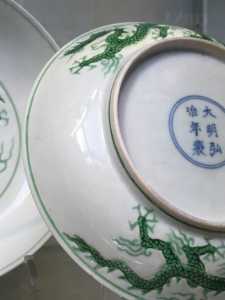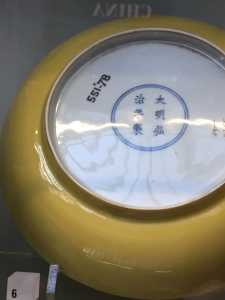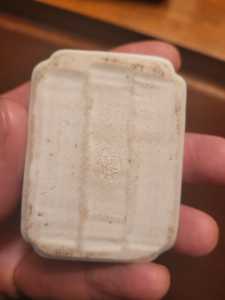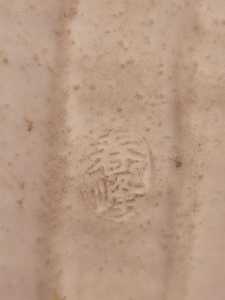The Chinese and Asian Art Forum. For Fans, Collectors and Dealers.
 Basic Rules For the BidAmount Asian Art Forum: Talk about whatever you want. You can even discuss and offer things that are for sale if they are authentic. Maximum image file size per post is 2 MB. Images of 700pxl x 700pxl are optimal if saved at a medium resolution. Be respectful of others and enjoy yourself. Click the YouTube link for a brief tutorial on using the forum. You can also EMBED Videos by cutting and pasting from You-Tube, Vimeo etc.
Basic Rules For the BidAmount Asian Art Forum: Talk about whatever you want. You can even discuss and offer things that are for sale if they are authentic. Maximum image file size per post is 2 MB. Images of 700pxl x 700pxl are optimal if saved at a medium resolution. Be respectful of others and enjoy yourself. Click the YouTube link for a brief tutorial on using the forum. You can also EMBED Videos by cutting and pasting from You-Tube, Vimeo etc.
NOTE: To post an item or add a new post, click open the category title from the FORUM LIST, and CLICK the Blue ADD TOPIC button.
I would like to learn from other members knowledge about fine Ming porcelain. I was watching a video of Nicholas Chow handling a couple objects from Chenghua and Xuande, and it was remarkable to see the footrim on one bowl in particular, how white and smooth it looked, like it was brand new and completely clean, even though it is 500 years old. Why is the porcelain so beautiful from back then, and is that also why it seems to hold up so well? In addition to the beautiful white color of the paste, did the way they made things at time also make them stronger and more durable? John
I think that bird feeder I posted on the other thread was Ming. But I could be wrong. But if it is that’s how great they can look after all those years.
@shinigami The less fine like the crazy eyed dragon featured on the forum in the recent past would be a big thrill for me and it would have the same 'antique' thrill, not all the Chinese lived at court and they had value to those poor folk and they survived.
John,
The materials were the same as other porcelain of the times. The manufacturering process would be the most refined of the times for the use of the Emperor. It also comes down to how it was handled in the Imperial household. I’m sure there was breakage involved with the handling of pieces designated for food service for the Imperial family. After a couple of years, the bowls & dishes would be mostly retired to storage as new production came into use. Otherwise , these items were protected and well cared for by the Palace over the centuries. They were not sold off or given away in mass quantities. Some might be stolen in times of chaos. Not until the sacking of the Summer Palace in the later half of the 19th century did relatively large quantities of earlier Imperial porcelains reach the Western market.
@shinigami How do museums put such cool looking numbers on their things? Makes me want to hire someone from a museum just to come over to my house one day and number all my stuff, for no other reason than I like how it looks.
Hi - William is quite correct, such pieces were produced in the finest materials and to the highest standards the Imperial workshops could achieve, in whatever media ...
I would only add that quality control standards were exceptional high throughout the 15th century, the slightest defeat in body, finish, overal design, cobalt/enamel or glaze tones would result in the piece been destroyed and buried. The vast amount of shards excavated at the Imperial kiln site, Jingdezhen, since the 1980's has revealed the extent of this regurious control system, even perfect pieces, left over when quoters were meet, were not allowed to leave the kilns and therfore destroyed ...
Standards slipped from the early 16th century when quantity replace quality and private kilns were brought into help meet the vast orders ...
Once handle, these early 15th century pieces are never forgotten, especially Yongle and Xuande wares, there have an exquisite 'feel' are are incredibly refined ...
Stuart
@ming1449 Thank you for sharing that information. Do you know during what reign the quality changes started to happen in a downward direction? Specifically I'm curious where does Jiajing fit into this history? Also, can you speak more to how you would describe those highly refined wares having handled some of them yourself? I realize words are limited, but I'd love to hear your attempts at meaningful descriptions. Thanks so much! John
I have recently gotten tired of sicking notes to the back of pieces to denote what they are, and debated using a number system and a hard copy in a ledger for the ones I intend to keep. I have spoken with a few friends who are on the curatorial staff of a few DC institutions, and they have advised me that an enamel which is soluble in either Acetone or Iso alcohol is advisable, as it is completely reversible.
Just a thought.
Jeremy
@jbeer2121 That’s a good idea. Each piece of my collection has a word file with information but it’s only identified by pictures in the file. I have thought about using stickers, but a simple water soluble office pen might do as well.
Birgit
Hi - Quality control, in terms of glaze and finish, was consistently high for Imperial Ming during the 15th century, although, personally, I feel that overall painting styles begin to slowly decline after Zhengtong, so 1450, losing the freedom and boldness of the early wares. Obviously, the blue and white and enamelled Chenghua wares are regarded as one of the pinicals of ceramic production but, when compared with Yongle, Xuande and Zhengtong pieces, the motif and compositions displays some stiffness in execution. Monochrome wares are the same, pieces after 1450 start to lack the beautiful depth of colour and tone found in the early wares, although I would agree that the Imperial yellow of Hongzhi wares is without equal ...
Quality control in all areas, body, painting, enamels, glaze and finish on Imperial Ming wares steadily declined during the Zhengde period onwards, so early 16th century and this decline accelerated during Jiajing due to the vast orders placed by the Imperial household. To give some examples, the Taoshu (Book of Ceramics) records that from the 10th through to 33rd years of Jiajing, so 1531-1554, 534,821 pieces of porcelain were made. The Fuliang xianzhi (Gazette of Fuliang) records that 127,201 pieces were produced between 33rd to 38th year of Jiajing, 1554-59 and the Ming Shenzong shilu ( Veritable Records of the Emperor Shenzong) records 239,000 pieces made in the 1oth year of Wanli, 1591 ...
To cope with such huge demands the Imperial Factory adopted a system of commissioning minyao, private, kilns to fire a proportion of Imperial wares to fulfill these orders which, inevitable, also lowered standards ...
Trying to describe the 'feel' of such wares is rather difficult!! I can only say that the earier Yongle and Xuande pieces display an incredible 'refinement' of body, glaze, and finish whilst any designs are beautiful executed - the 'whole' been just exquisite to look at, hold, feel and closely examine. Chenghua pieces have a wonderful body and glaze but, for me, they lack the 'overall refinement' found on these earlier wares - but this is only a personal opinion ...
Stuart
@ming1449 Thanks for all this information Stuart. I would like to ask what you think of the base of this piece I have. I have begun to wonder if it might be older than I previously thought. I can show pictures of the whole thing later, but first I just wanted your opinion about the color and style of the base and the impressed mark, which I wonder if it might possibly be related to the Jiajing period. Do you think the color of this base could possibly be from something Ming, or would you think it would be from something more recent? John
I think a pen would work, however making sure that it is something that won't be absorbed when drying in any way is key, I think an enamel like nail polish would in a way be ideal, as it dries it forms a coating instead of possibly seeping. I have a few enamel paints I was going to try but then realized they cost an enormous amount compared to cheap nail polish.
Jeremy
Hi - my pleasure to forward said information. As to the base images posted, rather difficult to say whether Jiajing period but I do not recognise the impressed mark and, from the colour/tone and finishing I suspect later ...
But I could well be wrong, and would need to see images of the whole object ...
Stuart
Thanks for visiting "The BidAmount Asian Art Forum | Chinese Art"
If you sell on eBay, or have a shop feel free to post images and descriptions and links.
Check back often for discussion about the latest news in the Chinese art and antique world. Also find out about the latest Asian art auctions at Sotheby's, Christie's, Bonhams and Tajans.
Auction results for: fine porcelain, ceramics, bronze, jade, textiles and scholar's objects. As well as Japanese, Thai, Vietnamese and other Asian cultures.
Thank you,
Peter Combs
Topics and categories on The BidAmount Asian Art Forum | Chinese Art
Kangxi vases, Kangxi dishes and chargers, Kangxi ritual pieces, Kangxi scholar's objects, Qianlong famille rose, Qianlong enamels, Qianlong period paintings, Qianlong Emporer's court, Fine porcelain of the Yongzheng period. Chinese imperial art, Ming porcelain including Jiajing, Wanli, Xuande, Chenghua as well as Ming jades and bronzes.
The BidAmount Asian Art Forum | Chinese Art
A free Asian art discussion board and Asian art message board for dealers and collectors of art and antiques from China, Japan, Korea, Thailand, Cambodia, Vietnam and the rest of Asia. Linked to all of the BidAmount Asian art reference areas, with videos from plcombs Asian Art and Bidamount on YouTube. Sign up also for the weekly BidAmount newsletter and catalogs of active eBay listing of Chinese porcelain, bronze, jades, robes, and paintings.
The art of calligraphy - and for the ancient Chinese it certainly was an art - aimed to demonstrate superior control and skill using brush and ink. Calligraphy established itself as one of the major Chinese art forms during the Han dynasty (206 BCE - 220 CE), and for two millennia after, all educated men were expected to be proficient at it.
The Museum’s collections of Asian art span nearly five millennia and encompass the cultures of China, the Himalayas, India, Japan, Korea, and Southeast Asia. In 2007, the Museum launched an initiative to create dedicated galleries for the collection, beginning with a gallery for the arts of Korea ...
Chinese art is full of symbolism, in that artists typically seek to depict some aspect of a totality of which they are intuitively aware.
China Online Museum is the finest online museum of Chinese art. It features Chinese calligraphy, painting, ceramics, bronzes, carving, and other artworks.
Chinese Ceramics & Works of Art. Overview Upcoming auctions Contacts Auction results ... Christie’s sales of Chinese ceramics and works of art showcase centuries of Chinese history. Held throughout the year in London, New York, Paris and Hong Kong, they attract a wide audience of collectors and connoisseurs vying for pieces as diverse as ...
Explore Asian Art Week. Contact the Specialist Department. Chinese Paintings ... Senior Specialist, Head of Sale. [email protected]. Tel:+1 212 641 5760. Bid in-person or online for the upcoming auction:Fine Chinese Paintings on 10 September 2019 at New York. Bid in-person or online for the upcoming auction:Fine Chinese Paintings on 10 ...
Discover an abundance of must-see art from all corners of a vast continent at Christie’s NY Asian Art Week. From contemporary classical and Chinese paintings to works with exemplary provenance from the Art Institute of Chicago, our Rockefeller Paza galleries will be full of ancient treasures and contemporary masterworks in a salute to the vibrant arts of Asia.
Sold to benefit The Art Institute of Chicago’s Asian Art Acquisition Fund, the sale features 84 lots with a focus on Ming and Qing porcelains, and offers a rare insight into the taste for collecting Chinese ceramics and works of art in the Midwest from the end of the 19th century through the 1980s. Highlights include two Wanli wucai garlic-head vases, a Qianlong mark and period, blue and ...
Specialist, Chinese Paintings, Christie's London Dr Malcolm McNeill is a Specialist in Chinese Paintings at Christie’s, based in London. He previously worked as an assistant curator of the Chinese collections and the Victoria and Albert Museum in London, as a researcher at the British Museum, and as a translator and tour guide at the National Palace Museum in Taipei.
The Christie's Education 2020 Conference: The Chinese Art Market 18 Jun 2019 Christie’s Education is delighted to announce our first international academic conference in Asia which will take place in Hong Kong from 26-27 November 2020 at the Hong Kong Convention and Exhibition Centre and will run in parallel with Christie’s Hong Kong Autumn Auctions.
The summer Chinese Art sale in Hong Kong will feature works of art from several private collections, including Qing porcelains and textile from the collection of the legendary Chinese art dealer A. W. Bahr (1877–1959), fine gilt bronze Buddhist sculptures from an old Hong Kong collection, an East Asian collection of Qing dynasty wine cups and jades, and a Japanese collection of Song ceramics ...
Sotheby's Chinese Works of Art Department holds two auctions each year in London, New York, Hong Kong and Paris.
Chinese Art - View Auction details, bid, buy and collect the various artworks at Sothebys Art Auction House.
With more than 340 Chinese works of art dating from the Neolithic to the Republic periods, highlights of this sale include a selection of Qing Imperial monochromes from the collection of Arnold and Blema Steinberg, early ceramics from the Art Institute of Chicago and Chinese porcelain and works of art from the collection of Henry Arnhold.
Results: Sotheby's Asia Week achieved $52.4 million in six strong auctions, exceeding pre-sale estimates. With 76.5% of lots sold and 60.3% of lots surpassing high estimates, the Asian art sales at Sotheby's indicate continued collector interest in the finest works of art from China, India and and the Himalayas.
Today's sale of Important Chinese Art will proceed as planned with sessions at 10 AM and 2 PM EDT. Sotheby's will be monitoring the weather conditions throughout the day and will be available to coordinate alternative bidding options should conditions make it difficult for clients to attend the auction in person.
Bonhams Chinese Art department is renowned for offering the finest works of art representing the richness and breadth of China's artistic heritage, particularly Imperial porcelain, white and spinach green jades, cloisonné and Buddhist art. Specialised international auctions are held globally, including London, Hong Kong and San Francisco.
Bonhams : Chinese Works of Art We use cookies to remember choices you make on functionality and personal features to enhance your experience to our site. By continuing to use our site you consent to the use of cookies. Please refer to our privacy and cookie policies for more information.
Bonhams Fine Art Auctioneers & Valuers: auctioneers of art, pictures, collectables and motor cars. We use cookies to remember choices you make on functionality and personal features to enhance your experience to our site. By continuing to use our site you consent to the use of cookies. ... Chinese Art (US) General enquiries
Bonhams : Fine Chinese Art We use cookies to remember choices you make on functionality and personal features to enhance your experience to our site. By continuing to use our site you consent to the use of cookies. Please refer to our privacy and cookie policies for more information.
Bonhams Fine Art Auctioneers & Valuers: auctioneers of art, pictures, collectables and motor cars Bonhams : Asian Art We use cookies to remember choices you make on functionality and personal features to enhance your experience to our site.
Bonhams are international auctioneers of fine Chinese and Japanese art. We specialise in rare Imperial and Export Chinese ceramics and works of art, as well as Japanese ceramics, fine and decorative works of art from the Neolithic Period to the 20th century. View on map
Bonhams Fine Art Auctioneers & Valuers: auctioneers of art, pictures, collectables and motor cars. We use cookies to remember choices you make on functionality and personal features to enhance your experience to our site. By continuing to use our site you consent to the use of cookies. ... Asian Art Bonhams. Work. 22 Queen St.




